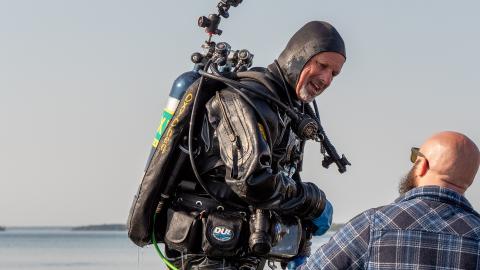
This big ball we live on is mostly water, with over 71% of the Earth’s surface covered by water, it’s no wonder the seas and oceans have been drawing fearless human explorers since… well, since long before anyone had goggles, snorkels and pressure-proof watches, that’s for sure. Even now, the ocean is an alien realm to us, with divers feeling like astronauts as they plumb the depths.
So how did we get from the earliest days of freediving – essentially, holding your breath and hoping for the best – to modern-day scuba adventures? It’s a story that whisks us back thousands of years, so let’s plunge in.
Sponge seekers, pearl catchers and watery warriors
The Ancient Greeks were fond of using sea sponges in the bath. These were natural sponges, those curious creatures of the deep which happen to be one of the oldest life forms we know of (scientists believe them to be a common ancestor of all animals on the planet). Sea sponges were so popular that they make cameo appearances in Homer’s Odyssey and the great philosophical ponderings of Plato and Aristotle.
The demand meant sponge divers were very much a thing, with the Aegean island of Kalymnos becoming particularly well known as a hotspot for gathering sponges. The brave divers would strip naked, hold their breath and plummet through the waters with the help of a heavy stone weighing them down. They’d stay down there for minutes at a time, cutting sponges and gathering them in bags – a lucrative bounty in those days.
This kind of free diving also has a long and proud history over in Japan, where the Ama, or 'women of the sea', have been hurtling down into the depths for perhaps 2,000 years. The women, originally clad only in loincloths, would search for shellfish, seaweed and pearls – a tradition that continues today, though contemporary Ama wear wetsuits and probably have a more pleasant time of it.
Military diving also has a longer history than you might think. One fabled ancestor of today’s elite frogmen and women was Hydna of Scione, who – along with her similarly skilled father – helped destroy enemy ships in a deadly naval battle between the Greeks and the Persians in 480 BC. According to the historian Pausanias, father and daughter swam miles out to secretly meet the Persian fleet and use knives to cut the ships’ moorings, causing many to crash and sink.
The pioneers of modern diving
Take a glass, stuff the bottom with some dry kitchen towel and plunge it upside down into a basin of water. On removing the glass, you’ll see the towel remains dry, despite the glass having been fully submerged in water. Voila: you’ve just demonstrated the principle behind the diving bell, an innovation which expanded the possibilities of diving.
These rigid, airtight, open-bottomed chambers would be lowered into the sea, taking with them a reserve of air which would become compressed at the top of the chamber. This trapped air could then be used as a reservoir for divers to return to and take gulps of air during their excursions. While the diving bell principle was described by writers as distant in time as Aristotle, its 'modern' origins can be traced back to the 16th Century.
From that point on, a number of innovators improved the basic design. One such clever clogs was none other than Sir Edmond Halley, of comet fame, who developed a diving bell which had barrels of air attached to it, to replenish the amount of oxygen divers could make use of. Halley made a flamboyant demonstration of his device by diving in the River Thames for more than 90 minutes.
As for the practical diving suit... this was a slow evolution over time, with one of the first pioneers being a particularly hard-working fellow in Devon called John Lethbridge. Somehow finding the time to invent things while being the father of 17 children, Lethbridge came up with an early diving suit in 1715. The word 'suit' is probably stretching things a bit: it was essentially a massive barrel with a porthole and a couple of holes to put his arms through. This wasn’t just some novelty experiment by a hapless eccentric, though. The suit made Lethbridge’s fortune, as he used it to salvage shipwrecks and recover buried treasure.
Of course, it was a far cry from any diving suits we would recognise today. It wouldn’t be until the 1820s that the next leap forward came, thanks to the unlikely inspiration of a fire on a farm in Whitstable. When the fire broke out, the billowing smoke meant rescuers couldn’t get into the stables to free the horses trapped there. Onto the scene stepped one John Deane, who had the marvellous idea of donning the helmet from a suit of medieval armour. As the legend goes, he asked the local fire brigade to run a hose into the helmet to supply him with air, which allowed him to brave the smoke and get the horses to safety.
He and his brother Charles later turned this impromptu invention into a proper, copper helmet for fire-fighting, and that in turn evolved into an early diver’s helmet. John Deane would make excellent use of his own creation when the wreck of the Mary Rose, that iconic Tudor ship, was rediscovered in the Solent in 1836. Deane was one of the men who salvaged the ship, resurfacing with Tudor weapons among other long-lost treasures. (Interestingly, the Tudors themselves had originally sent divers down to recover guns from the ship, and one of them was Jacques Francis, a Guinean diver who’d later become the first black person to give evidence in an English court).
Going deeper
The development of breathing regulators, allowing for the controlled inhalation of oxygen, in the 19th Century paved the way for the age of scuba diving. The word 'scuba' itself actually began as an acronym for Self-Contained Underwater Breathing Apparatus, a phrase coined by Major Christian Lambertsen, who developed diving apparatus for US Navy frogmen in World War Two.
Of course, scuba diving has since gone mainstream and is hugely popular with holidaymakers eager to come face to face with intricate reefs and darting, colourful sea life. Though not many holiday will attempt diving feats such as Ahmed Gabr, who on 18 September 2014 descended over 332 metres into the Red Sea – the deepest any human being has ever gone. So deep, in fact, that he had to spend 14 hours slowly resurfacing to avoid decompression sickness.
If only those sponge divers of Ancient Greece could see us now.





















